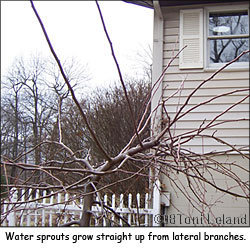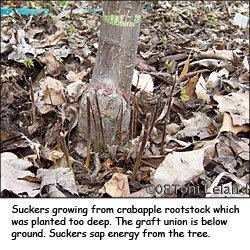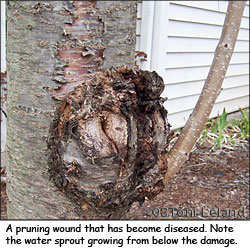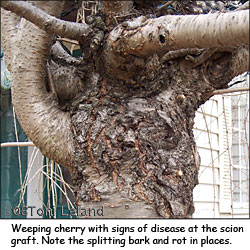





Ornamental fruit trees are not the only species for which a weeping habit has been cultivated, but these flowering trees are among the most popular for home landscapes. The weeping cherry at right is quite magnificent, but has clearly outgrown the small space originally allocated when it was a sapling. So this is one of the problems to consider when purchasing an ornamental tree. Other common problems associated with grafted trees include water sprouts, suckers, and diseases. The process of grafting is such that one or two areas of the plant are stressed in the beginning, with the potential of reducing the vigor of the plant.
How Is Grafting Done?
A single graft is the process of merging a less hardy species onto very hardy rootstock. For instance, a weeping crabapple cultivar would be grafted to standard crabapple rootstock, making the resulting tree better able to withstand the elements. This is done by aligning the cambium layers so they will grow together.
A double graft uses the same technique of combining hardy rootstock and hardy main trunk stock called the interstem graft, but takes the process one step further by grafting the desired cultivar to the top of the trunk. This top portion of the tree is known as the scion and is the only part of the tree that will produce the desired leaves, flowers, and/or fruit. The interstem and rootstock will regulate the mature size of the tree. Grafted trees can fail within the first few years of life, particularly as a result of severe weather stress. The key to assuring that you buy a healthy tree is purchasing from reputable nurseries and garden centers that provide at least a one-year guarantee. Discuss with the grower what type of graft has been done, and understand the mature size of the tree, as well as its care.
Water Sprouts
Epicormic branches are known as water sprouts and are easily recognized on a weeping variety. Water sprouts grow straight up, and they grow quickly, sometimes reaching 3 to 4 feet long in a single season. These branches will not flower or produce fruit, but will sap energy from the tree. They should be pruned close to the collar as soon as they begin to appear.
Suckers
Suckers grow from the rootstock of the tree and, again, sap energy from the plant. Suckers are hard to control, but the main reason for the problem is an improper planting depth at the time the tree is situated. The graft union must be above ground in order to prevent the growth of suckers. If the tree is already planted, when suckers begin to appear, clear away the soil from around the base of the tree and prune the suckers as close to their source as possible. Replace the soil. This will not p revent more suckers from growing, but if done frequently, they will not affect the vigor of the tree.
revent more suckers from growing, but if done frequently, they will not affect the vigor of the tree.
Disease
As with the wound caused by a broken branch or limb, the wound of grafting is susceptible to disease and insect invasion. Before purchasing, check the graft union carefully to be sure there are no cracks or irregular growth. Cherry and plum are particularly prone to disease at any wound or weak crotch. Large globs of amber-looking material will ooze from the wound or beneath the bark, eventually turning black. Consult your nursery for advice on how to manage this situation.
Location
As mentioned before, be sure you know the mature size of the tree you are considering. If a weeping cultivar has been grafted to the interstem of a full-size tree, you will not be able to contain the tree as it matures. Again, know what you are buying.
ConiferousSome Popular Varieties of Weeping Trees1
Needle juniper (Juniperus rigida)
Tolleson's weeping juniper (Juniperus scopulorum 'Tolleson's Weeping')
Weeping Eastern red cedar (Juniperus virginiana 'Pendula')
Weeping Alaska cedar (Chamaecyparis nootkatensis 'Pendula')
Weeping Serbian spruce (Picea omorika 'Pendula')
Weeping white spruce (Picea glauca 'Pendula')
Deciduous
'Chaparral' weeping mulberry (Morus alba 'Chaparral')
'Louisa' weeping crabapple (Malus x 'Louisa')
Golden weeping willow (Salix alba 'Tristis')
Weeping Eastern white pine (Pinus strobus 'Pendula')
Weeping European beech (Fagus sylvatica 'Pendula') and (Fagus sylvatica 'Purple Foundtain')
Weeping European larch (Larix decidua 'Pendula')
Weeping Higan cherry (Prunus subhirtella 'Pendula')
Weeping katsura (Cercidiphyllum japonicum 'Pendulum')
Weeping Norway spruce (Picea abies 'Inversa')
Copyright © www.100flowers.win Botanic Garden All Rights Reserved